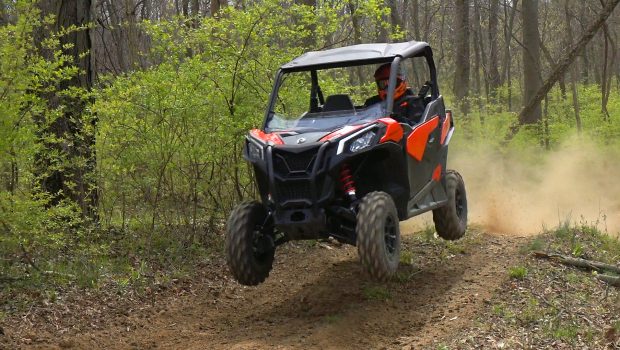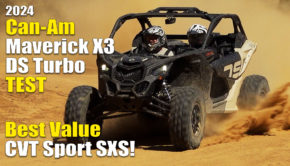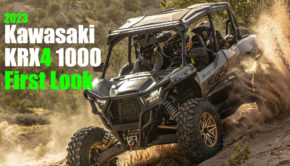2018 Can-Am Maverick Trail 1000 DPS Test: WITH VIDEO
Introduction

While the class limited Can-Am to building the machine 50” in width, they went big in other ways looking to surpass the competition. The result was the Maverick Trail 800 and 1000.
Can-Am is determined to be the first name in side-by-sides. After launching the first 72” wide Maverick X3, the company is currently offering both two and four-seat versions along with a number of 64” wide models. While the competition has been scrambling for the past couple years to bring their first 72” wide car to market, Can-Am was busy filling in a niche that was missing in their lineup, the 50” trail sport segment. While the class limited them to building the machine 50” in width, Can-Am went big in other ways looking to surpass the competition. The result was the Maverick Trail 800 and 1000.
Styled after the Maverick X3, the new Maverick Trails are available in standard and DPS models. The DPS models feature a ton of added features including Can-Am’s Dynamic Power Steering, faster engaging Visco-Lok QE auto locking front differential, an unlockable rear differential, selectable sport and eco engine modes, cast aluminum wheels, color matched suspension springs, and LED Running lights. Maverick trail 800s feature door nets while the 1000s come with half doors. We got our hands on a top of the line Maverick Trail DPS 1000 that was broken in at the Can-Am press intro, giving us an idea of how the car holds up after a few rough rides.
Without the “need” for a 50” car where he rides, test rider, Rob Frede, is a critic of the 50” segment having found limited ground clearance and cramped interior space to be issues in the past. We decided to see if the new Maverick Trail DPS could win him over on some tight trails originally cut for sport ATVs at the totally private Meyer Family Motoplex in southwest Ohio.
Engine

Leading its class in displacement, the Maverick Trail 1000 is powered by a rear mounted, water-cooled, 976cc, V-twin, Rotax Engine with four valves and double overhead cams per cylinder.
Leading its class in displacement, the Maverick Trail 1000 is powered by a rear mounted, water-cooled, 976cc, V-twin, Rotax Engine with four valves and double overhead cams per cylinder. With a class leading 10 gallon tank, fuel is delivered by an electronic fuel injection system, allowing for the use of Can-Am’s Intelligent Throttle Control System. The fly-by-wire system is designed to help filter out unwanted gas pedal inputs in rough terrain. The engine’s air intake is mounted high on the side of the vehicle. Can-Am uses a Donaldson airbox, which they say offers optimal filtration.
Said to use the same transmission used in the larger, heavier, and more powerful Maverick X3, transmission durability shouldn’t be an issue and helical cut gears are used to minimize noise. The automatic CVT style transmission features Can-Am’s Quick Response System, (QRS-T) featuring high and low forward ranges, neutral, reverse, and park. There are four selectable drive modes featuring two and four-wheel-drive, with or without the rear differential lock engaged to prevent damaging groomed turf surfaces. In four-wheel-drive, Can-Am’s Visco-Lok front differential offers the easy steering of a limited slip front differential. However, when one of the front wheels begins to lose traction, the Visco-Lok QE system progressively locks in both front wheels providing true four-wheel-drive. When traction is restored, the front differential progressively unlocks. Electronic Hill Descent Control comes standard on all models.

Can-Am’s Quick Response System, (QRS-T) features high and low forward ranges, neutral, reverse, and park.
Fuel injection allows the engine to start and warm up quickly. The engine produces a powerful sounding, yet well muffled, roar and emits very little vibration. We spent a short time flipping between the engine’s Sport and ECO modes. Although we didn’t measure any fuel savings that ECO mode provides, we can say that it does mellow out the power a bit for your less experienced friends or times when some extra manageability is desired. That’s not us, though, so we left it in sport mode most of the time.
Power is strong throughout the RPM range. It starts building right off idle, pulling hard in the midrange with a respectable top-end for its displacement. Strong low-end power rarely leaves you feeling as though you need to shift into low range, although we did shift into low on slower climbs, with two occupants, to protect the belt. The engine’s midrange rush will push you back in your seat. There’s enough power on tap to spin the tires accelerating from a dead stop or exiting corners making controlled power slides possible. We were able to get the car up to 65MPH with 500lbs of occupants on-board over a few hundred yards and the engine was still pulling.
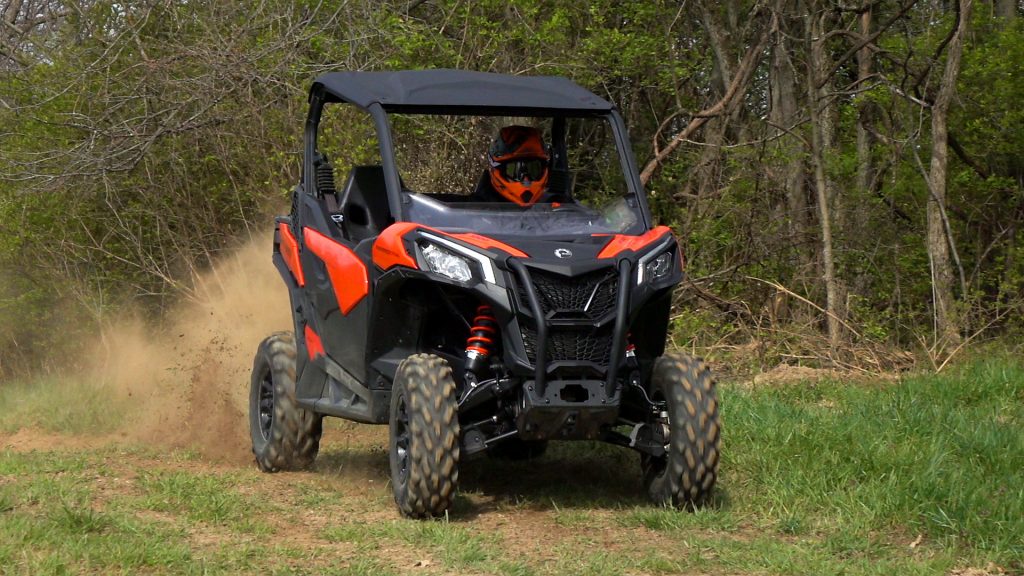
Power is strong throughout the RPM range. It starts building right off idle, pulling hard in the midrange with a respectable top-end for its displacement.
We feel the engine’s 75 horsepower is well matched with the chassis and more power could be excessive. We doubt it will hang with a Maverick X3 or RZR XP 1000 in a drag race, but it is very competitive with lighter RZR 900.
The Quick Response transmission lives up to its name. Power was always on tap entering and exiting corners or times on hills when we needed to get out then back in the throttle. The engine and transmission combination lend themselves to aggressive sporty driving although the smooth, predictable power delivery make the Maverick Trail perfect for casual exploring or destination drives.

We doubt it will hang with a Maverick X3 in a drag race, but it is very competitive with lighter RZR 900.

Can-Am’s Intelligent Throttle Control system did well at filtering unwanted pedal inputs caused by traversing bumps, keeping throttle control feeling consistent.
At first we were wishing for a heel pocket in the floorboard, which helps you better control gas pedal inputs; Can-Am’s Intelligent Throttle Control system did well at filtering unwanted pedal inputs caused by traversing bumps, keeping throttle control feeling consistent. We didn’t notice much in the way of throttle lag when asking for a large dose of throttle. We’re not sure how it would work on a long-travel car, setting up for jumps or whoops where precise throttle inputs are needed, but for the trail, Intelligent Throttle Control works as pretty well.
With the faster engaging Visco-Lok QE front differential system equipped on the DPS model, we have no complaints when it comes to four-wheel-drive performance. If you typically challenge steep or deep technical terrain, you’ll prefer the faster locking front differential on the DPS model. Engine braking is a welcomed feature on a trail car. In high-range, the Can-Am’s engine brake feels natural when scrubbing off speed. In Low, the Electron Hill Descent Control keeps you crawling along at a snail’s pace on steep descents.

If you typically challenge steep or deep technical terrain, you’ll prefer the faster locking front differential on the DPS model.
Chassis and Suspension

The Maverick Trail is built on a brand new chassis that’s constructed of DP980 and high strength low alloy, (HSL) steel. Used as the base for the new 60” wide Maverick Sport, the chassis should be overbuilt for the 50” Trail.
The Maverick Trail is built on a brand new chassis that’s constructed of DP980 and high strength low alloy, (HSL) steel. Used as the base for the new 60” wide Maverick Sport, the chassis should be overbuilt for the 50” Trail. The chassis is protected by an integrated removable front bumper and the underside is covered end to end by injection molded plastic skid plates.
Dual A-Arm suspension front and Can-Am’s TTA-T dual-arm rear suspension delivers 10” of movement front and 10.5” rear. Suspension action is controlled by preload-adjustable, twin-tube, gas charged shocks and sway bars at both ends. Single-mode, Dynamic Power Steering is outfitted on all DPS models. The Maverick Trail rolls on 26s8-12 front and 26×9-12 rear, Carlisle ACT tires.

Dual A-Arm suspension front and Can-Am’s TTA-T dual-arm rear suspension delivers 10” of movement front and 10.5” rear.
Measuring in at the trail class standard width of 50”, the Maverick trail has a much longer wheelbase than its competitors at 90.6”. That’s nearly 7” longer than the Textron Wildcat Trail and nearly one-foot longer than the Polaris RZR 900; in fact, it’s a claimed 6/10” longer than a 64” wide RZR XP 1000. The Trail’s suspension travel, 69” height, 10” of ground clearance are all pretty much in line with other vehicles in the class. Its claimed dry weight of 1,364lbs is 188lbs heavier than the claimed dry weight of the RZR 900 EPS––not a big deal if it results in a more comfortable, better performing machine.

the Maverick trail has a much longer wheelbase than its competitors at 90.6”. That’s nearly 7” longer than the Textron Wildcat Trail and nearly one-foot longer than the Polaris RZR 900;
The Maverick delivered a ride that exceeded our expectations. It was hard to find serious fault with the suspension. It smoothed out everything we threw at it from small roots and rocks up to getting a little air. Flying through the fields over 50mph, we were impressed with its ability to eat up small rolling bumps, ripples, and potentially harsh high-speed impacts from small water ruts. Bump compliance at lower speeds was equally impressive. The rear end seemed a bit firmer although the ride didn’t feel overly imbalanced. We believe that Can-Am went with a slightly firmer rear setting to keep the back end from squatting excessively under acceleration or on steep climbs helping maintain usable ground clearance. You can soften the rear and firm up the shocks’ preload settings if you like; however, we were able to clear some surprisingly large obstacles in the trail. Also, when landing from a water break jump in mild ruts, the back end of the chassis would frame out before the shocks would bottom–– common on all 50” UTVs we’ve driven. We feel the firmer rear settings worked well with the limited ground clearance of the class.

The suspension smoothed out everything we threw at it from small roots and rocks up to getting a little air.
The Maverick’s long wheelbase really adds to its smooth riding characteristics. It places you in the middle of the car and farther away from wheels, further away from the bumps. Its longer wheelbase and suspension combine providing a high level of high-speed stability on fast, somewhat smooth trails. The long wheelbase is also a welcomed asset on most steep climbs and descents, only becoming a concern when tackling a hill or creek bank with an abrupt transition at the top where the car’s longer wheelbase makes it more susceptible to framing out. The wheels protrude at both ends, so steep, abrupt transitions at the bottom of hills aren’t an issue.
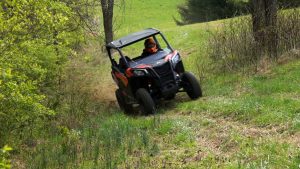
Body roll is well managed allowing you to corner and negotiate off-camber trail sections with confidence, although you quickly learn that any 50” side-by-side handles far better with two occupants on board.
Body roll is well managed allowing you to corner and negotiate off-camber trail sections with confidence, although you quickly learn that any 50” side-by-side handles far better with two occupants on board. Steering accuracy was good in either two or four-wheel-drive, so we left the car in 2wd most of the time. We found that we could get through turns a little faster with the back end broke loose and stepped out a few degrees. Ample power allows you to break the back tires loose and the longer wheelbase smooths out the point at which the back end breaks and regains traction in slides making driving with the throttle a little more predictable.
Can-Am’s power steering is well balanced on the Maverick. Steering effort is light while leaving you feeling connected to the trail. We appreciated it in tight conditions where the car’s slightly wider turning radius had us working the limits of the steering from time to time.

Steering effort is light while leaving you feeling connected to the trail. The longer wheelbase smooths out the point at which the back end breaks and regains traction in slides making driving with the throttle a little more predictable.
Carlisle’s ACT tires provided good directional control, but were easy to break traction with under acceleration in 2wd. This aided in getting loose in turns with four-wheel-drive providing extra traction when needed. They provided some fun, but backcountry explorers may want a bit more bite.
Brakes

Braking force is provided by dual hydraulic disc brakes at both ends featuring 220mm rotors and dual-piston calipers all around.
Braking force is provided by dual hydraulic disc brakes at both ends featuring 220mm rotors and dual-piston calipers all around. The brakes offered excellent power and feel, and the front-end doesn’t dive excessively under hard braking.
Interior and other details
Can-Am is claiming 2” more leg room than its main competitor, which we can only assume is the RZR 900. The driver’s seat can be slid fore and aft a total of 5” and the tilt steering offers 25 degrees of adjustment. The backlit, LED, instrument display is mounted on the steering column. It’s not flashy looking, but functional. The passenger seat and grab handle are not adjustable, but are well positioned for most adults. Three point, anti-cinch seatbelts come standard and are comfortable. The seatbacks and cage are 4-point harness ready for those who like a little extra security.

Overall, the interior of the Maverick Trail is pretty refined and surprisingly spacious for a 50” wide machine.
Overall, the interior of the Maverick Trail is pretty refined and surprisingly spacious for a 50” wide machine. Stepping into the car, there is plenty of legroom for big Rob at 6’2”. We found considerably more shoulder room for two NFL size riders than we remember in 50” RZRs in the past, although the rather nice doors do impede the driver’s left arm movement a bit, especially larger drivers. The seats remain pretty comfortable without any annoying pressure points, and even after 7 hours of almost non-stop driving. We really like the shape and feel of the steering wheel. Both it and the steering column feel solid. All of the switches and the gated shifter feel high-quality, although the door handles feel a bit flimsy. The driver’s sight line out of the front of the car isn’t bad; however, drivers of all sizes found viewing out the back of the car difficult. Shorter drivers will find a rear view mirror almost mandatory.

There’s a class leading 5.3 gal of dry storage available inside the cockpit with driver and passenger side storage boxes.
There’s a class leading 5.3 gal of dry storage available inside the cockpit with driver and passenger side storage boxes. There’s a small tray below the DC outlet in the center dash, and cup holders are located on the floor on the driver and passenger sides.
Unique LED daytime running lights make you more visible to others during the day. Visibility at night is provided by dual 55 watt headlights up front. LED tail and brake lights are found out back.

We found considerably more shoulder room for two NFL size riders than we remember in 50” RZRs in the past,
Storage and towing
In addition to the interior storage, the cargo bed can carry 300lb. The bed has 8 LinQ quick attach points for Can-Am accessories, 4 anchor hooks, and four drain holes for easier cleaning. The car’s two-inch receiver hitch can tow 1,500lb.
Accessory integration
With over 125 accessories already available, Can-Am can outfit the trail for any season or trail environment before or after your car leaves the dealer. Our machine was outfitted with their LinQ Rack Extension, half windshield, and sport roof.
Conclusion
Can-Am has raised the bar in the 50” trail class. While its sheer engine performance may not be heads and shoulders above its closest competitor, it is certainly impressive and driver friendly. The Maverick sacrifices a little turning radius and ground clearance cresting hills for a car with more predictable climbing, high-speed stability, and a smoother ride. Where the Maverick really shines is its level of refinement; from its well-thought-out spacious cockpit to its trail-tuned suspension, every aspect of the car performs well individually and as a total package. Rob and the rest of us all came away with a little more respect and appreciation for the 50” class after spending a few weeks testing the Maverick Trail.
The Maverick Trail is sure to be a hit with tight trail sportsters. With the level of accessory integration, ability to navigate in the tight stuff, and camo models available, we wouldn’t be surprised to see them being used for hunting out in the deep woods.

with the top of the line Maverick Trail 1000 DPS retailing for $14,799, the newest kid on the block could certainly be the one to beat in the 50” trail sport class.
Starting at $10,999, the base model 800 could offer the best performance for the dollar in the 50” trail sport class and is sure to attract a number of new enthusiasts looking for a quality, name brand unit at an affordable, entry-level price. Looking at the total package, with the top of the line Maverick Trail 1000 DPS retailing for $14,799, the newest kid on the block could certainly be the one to beat in the 50” trail sport class.
Machine: 2018 Can-Am Maverick Trail 1000 DPS
MSRP: $14,799
For more info: https://can-am.brp.com/
2018 Can-Am Maverick Trail 1000 DPS Ratings
Summary: The Maverick Trail is sure to be a hit with tight trail sportsters. With the level of accessory integration, ability to navigate in the tight stuff, and camo models available, we wouldn’t be surprised to see them being used for hunting out in the deep woods. Starting at $10,999, the base model 800 could offer the best performance for the dollar in the 50” trail sport class and is sure to attract a number of new enthusiasts looking for a quality, name brand unit at an affordable, entry-level price. Looking at the total package, with the top of the line Maverick Trail 1000 DPS retailing for $14,799, the newest kid on the block could certainly be the one to beat in the 50” trail sport class.

